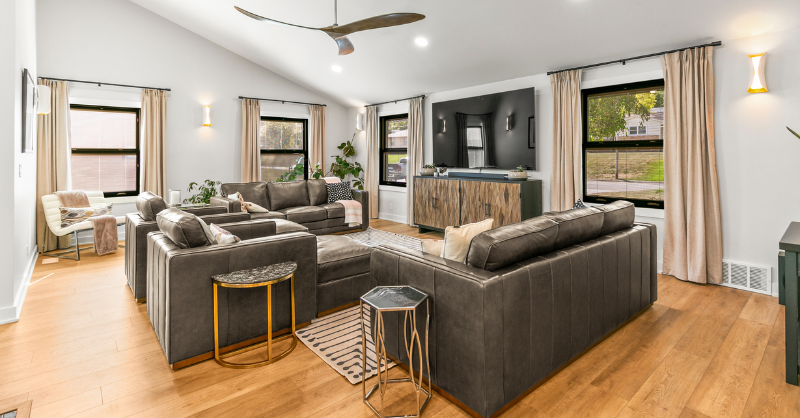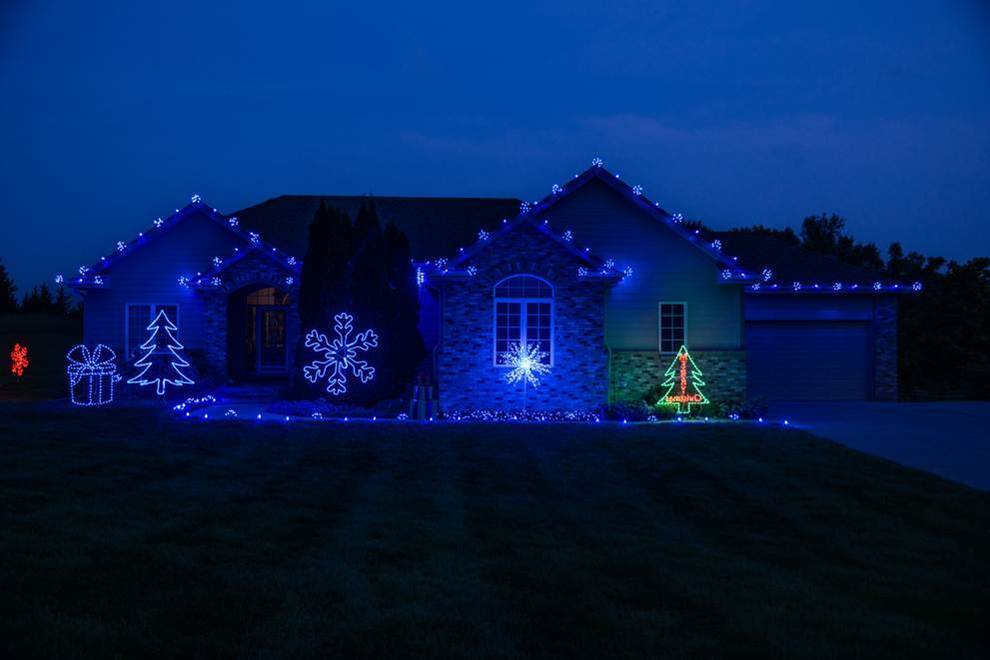How Long Does Interior Paint Last in Omaha?
October 18th, 2024
5 min read

Have you ever stood in your living room, coffee in hand, staring at that scuff mark on the wall you've been ignoring for months? Or maybe you've noticed your once-vibrant kitchen now looks a bit... well, sad? If you're nodding along, you're not alone. Many Omaha homeowners wonder when it's time to give their interior walls a fresh coat of love.
At Brush & Roll Painting, we've been transforming Omaha homes for years. We've seen it all - from walls that could use a touch-up after a year to those still looking fresh after a decade. Our team of painters has gathered a wealth of knowledge on what makes interior paint last in Omaha.
In this article, we'll discuss how long you can expect your interior paint to last and what factors play into its lifespan. By the time you finish reading, you'll be armed with the know-how to keep your walls looking fresh for years to come.
How Long Does Interior Paint Really Last?
Let's cut to the chase - on average, a quality interior paint job can last anywhere from 15 to 25 years. But hold your horses! Before you start planning your paint colors for the next decade, there's more to the story.
The lifespan of your interior paint isn't set in stone. It's more like a game of Jenga - lots of factors stack up to determine how long your paint will look its best. Let's break it down:
1. Interior Paint Quality
Remember that bargain bucket of paint you snagged on clearance? Well, it might end up costing you more in the long run. High-quality paints are like the marathon runners of the paint world - they're in it for the long haul.
These premium paints contain better binders and pigments that adhere to your walls more effectively. They're also more resistant to color fading, staining, and general wear and tear. According to a study by the National Association of Home Builders, using high-quality paint can extend the life of your paint job by up to 50%.
On the flip side, lower-quality paints start showing their imperfections quickly. You might notice fading, chalking, or even peeling within a couple of years.
 2. Surface Preparation Before Interior Painting
2. Surface Preparation Before Interior Painting
Imagine trying to stick a Band-Aid on a wet arm. It's not going to end well, right? The same principle applies to painting. Proper surface preparation is the unsung hero of a long-lasting paint job.
This prep work includes:
- Cleaning the walls thoroughly
- Repairing any cracks or holes
- Sanding rough spots
- Applying primer when necessary
A study by the Painting and Decorating Contractors of America found that proper surface preparation can increase paint adhesion by up to 300%.
3. Application Technique For Interior Paint
The way paint is applied can significantly impact its longevity.
Proper application involves:
- Using the right tools (brushes, rollers, sprayers)
- Applying even coats
- Allowing adequate drying time between coats
- Achieving the right mil thickness
A professional painter knows these techniques like the back of their paint-splattered hand. Their expertise can add years to your paint's life.

4. Room Usage: High Traffic vs. Low Traffic
Think about the rooms in your house. Your living room probably sees more traffic, while your guest bedroom might be used less often.
High-traffic areas like hallways, kitchens, and family rooms tend to need repainting more frequently. The walls in these areas are subject to more touching, bumping, and general wear and tear. On the other hand, low-traffic areas like formal dining rooms or spare bedrooms can often go longer between paint jobs.
5. Environmental Factors on Interior Paint
Your walls might not be baking in the sun, but they're still affected by their environment. Sunlight, humidity, and temperature fluctuations can all impact how long your paint lasts inside your home.
Rooms that get a lot of direct sunlight might experience faster fading. According to the U.S. Department of Energy, south-facing rooms receive up to three times more sunlight than north-facing rooms in the Northern Hemisphere. This extra sun exposure can cause paint to fade or discolor more quickly.
Humidity is another sneaky paint life shortener. In areas with high humidity (aka Omaha summers), paint can start to bubble or peel. On the flip side, extremely dry conditions can cause paint to crack.
It’s important to keep a steady temperature and humidity in your home at all times to avoid paint failure.
6. Cleaning and Maintenance For Interior Painted Walls
Your walls need a little TLC to stay looking their best.
Regular cleaning can help extend the life of your paint job. But be gentle! Harsh scrubbing or abrasive cleaners can wear down the paint finish. A soft cloth or sponge with mild soap and water is usually all you need to keep your walls looking fresh.
7. Water Damage on Interior Paint
Water damage can cause significant harm to your ceiling paint, wall paint, or woodwork. This damage may cause the entire surface to be repaired and repainted ASAP to avoid further issues.
Water damage to interior paint can come in a few flavors:
- Stains: These are those unsightly brownish or yellowish marks that pop up after a leak.
- Bubbling or Blistering: When water gets trapped behind the paint, it can cause the paint to bubble up.
- Peeling: Excessive moisture can cause paint to lose adhesion and start peeling off the wall.
- Mold Growth: In severe cases, water damage can lead to mold, which is not just unsightly but also a health hazard.
As the old saying goes, an ounce of prevention is worth a pound of cure. Here are some tips to protect your paint from water damage:
- Fix leaks promptly: If you notice a leak, don't wait. Fix it ASAP before it can cause damage to your paint.
- Control humidity: Use dehumidifiers in damp areas like basements.
- Ensure proper ventilation: This is especially important in bathrooms and kitchens.
- Use moisture-resistant paint: In areas prone to dampness, consider using paints specifically designed to resist moisture.
-Sep-24-2024-04-58-11-8248-PM.png?width=566&height=296&name=Blog%20Post%20Image%20Size%20(5)-Sep-24-2024-04-58-11-8248-PM.png)
Signs It's Time for a Fresh Coat of Interior Paint
Now that we've covered the factors that affect paint longevity, let's talk about how to tell when it's time to break out the rollers (or call in the pros). Here are some signs your walls are crying out for a refresh:
- Fading: If your walls are looking washed out or discolored, it might be time for a new coat.
- Peeling or bubbling: This is a clear sign that your paint is no longer adhering properly.
- Scuffs and marks that won't clean off: If your walls look like they've been in a bumper car race, it's probably time for a repaint.
- Outdated color: Maybe that avocado green seemed like a good idea in 2010, but if your walls are stuck in a time warp, consider an update.
- Chalking: If you run your hand over the wall and it comes away powdery, that's a sign of paint breakdown.
Your Interior Paint's Lifespan
The lifespan of your interior paint isn't just about the passage of time - it's about quality, preparation, application, and care. While on average you might be looking at repainting every 5-10 years, remember that you have the power to tip those odds in your favor.
By choosing high-quality paints, ensuring proper preparation and application, and giving your walls a little TLC, you can keep your home looking fresh and inviting for many many years to come. And when it is time for a refresher, remember that the team at Brush & Roll Painting is here to help.
We've been helping Omaha homeowners transform their spaces for years, and we'd love to bring our expertise to your next painting project. Whether you're looking to update a single room or give your whole house a transformation, we're here to ensure your paint job stands the test of time.
Ready to give your walls the professional treatment they deserve? Click the button below to get a quote. Let's work together to create a space you'll love for years to come!

If you think you’re ready for another interior painting project, but aren’t ready to get a quote, take this time to plan the steps. Whether you’re doing the project yourself or hiring a painter in Omaha, any interior painting project can be overwhelming.
It’s important while you tackle your project, to be confident throughout all the steps. So, we have created the interior painting project checklist for homeowners to feel comfortable throughout every phase of your project. Click the button below to download yours now!
Kaylea is the Brush & Roll Painting Content Manager. Kaylea is a Journalism and Media Communications summa cum laude graduate with a minor in Marketing from the University of Nebraska at Omaha. Kaylea manages the marketing for Brush & Roll Painting.















-Jul-23-2025-02-21-33-5468-PM.png?width=800&height=418&name=Blog%20Post%20Image%20Size%20(2)-Jul-23-2025-02-21-33-5468-PM.png)




-Oct-22-2025-01-39-19-5208-PM.png?width=800&height=418&name=Blog%20Post%20Image%20Size%20(1)-Oct-22-2025-01-39-19-5208-PM.png)





